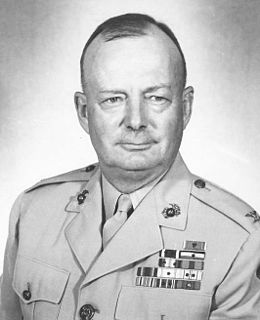
LeRoy Philip Hunt was a highly decorated officer in the United States Marine Corps with the rank of general. A veteran of World War I, he was decorated with the Navy Cross and Army Distinguished Service Cross, the United States military's two second-highest decorations awarded for valor in combat.

William John Whaling was a highly decorated Major general in the United States Marine Corps and an expert in jungle warfare during the Pacific War. He also competed as a sport shooter in the 1924 Summer Olympics, where he finished in 12th place in the 25 m rapid fire pistol competition.

Gilder Davis Jackson Jr. was a highly decorated officer of the United States Marine Corps with the rank of brigadier general, who is most noted for his service as commanding officer of the 6th Marine Regiment during the Guadalcanal Campaign.

Amor LeRoy Sims was a highly decorated officer of the United States Marine Corps with the rank of brigadier general, who is most noted as commanding officer of 7th Marine Regiment during World War II. He also served as chief of the Norfolk Police Department from 1949 to 1952.

Harold Ellett Rosecrans was a highly decorated officer of the United States Marine Corps with the rank of brigadier general, who commanded 2nd Battalion 5th Marines during the during the assault on Tulagi Island. He later commanded 17th Marine Regiment during Battle of Cape Gloucester.

William Stanley Fellers was a decorated officer of the United States Marine Corps with the rank of major general. He is most noted as Director of the Staff of the Inter-American Defense Board or as Supply officer of the 1st Marine Division during World War II.

Richard Hall Jeschke was a decorated officer of the United States Marine Corps with the rank of brigadier general, who commanded 8th Marine Regiment during the Battle of Guadalcanal. He later served in the European Theater and participated in the planning of the Invasion of Normandy and the Invasion of Sicily.

Raymond Paul Coffman was a decorated officer of the United States Marine Corps with the rank of major general. He is most noted as quartermaster of 1st Marine Division during Pacific War. Coffman later became the first commanding general of the Marine Corps Depot of Supplies Albany.

George Richard Edwin Shell was a decorated officer of the United States Marine Corps with the rank of brigadier general, who is most noted as the commanding officer of 2nd Battalion, 10th Marines during World War II. He later served as the 9th Superintendent of the Virginia Military Institute.

Wood Barbee Kyle was a highly decorated officer of the United States Marine Corps with the rank of major general. Kyle received two Silver Stars for gallantry in action during Pacific Campaign in World War II. He later took part in the Vietnam War and distinguished himself as commanding general of the 3rd Marine Division.

William Wallace Stickney was an American lawyer, SEC official and decorated officer of the United States Marine Corps with the rank of major general. He spent most of his Marine career as reserve officer, but was recalled to active duty during World War II and subsequently remained on active service as director of Marine Corps Reserve.

Odell Maurice Conoley was a highly decorated officer of the United States Marine Corps with the rank of brigadier general, who is most noted for his service with 2nd Battalion, 7th Marines during World War II. He completed his career as deputy director for Operations, Plans, Policies and Operations Division, staff of the commander in chief, United States European Command, in Paris, France.

Merlin Frederick Schneider was a highly decorated officer in the United States Marine Corps with the rank of brigadier general. He is most noted as commanding officer of 22nd Marine Regiment during the Recapture of Guam in July 1944, for which he received the Navy Cross, the United States military's second-highest decoration awarded for valor in combat.

William Capers James was an officer of the United States Marine Corps with the rank of brigadier general, most noted for his service as chief of staff, 1st Marine Division during the Guadalcanal Campaign and later as commanding officer, Marine Corps Base San Diego.

Joseph Charles Fegan Jr. was a highly decorated officer in the United States Marine Corps with the rank of lieutenant general. A son of Major General Joseph C. Fegan, he received several citations for bravery during three wars and completed his career as commanding general, Marine Corps Development and Education Command.

James Frederick Moriarty was a highly decorated officer in the United States Marine Corps with the rank of brigadier general. A veteran of World War I, he distinguished himself several times as a company officer with the 6th Machine Gun Battalion and received four awards of the Silver Star.

John Houghton Griebel was a decorated officer in the United States Marine Corps with the rank of Brigadier general. A veteran of Nicaraguan Campaign and Yangtze Patrol, he later distinguished himself as commanding officer, 5th Marine Regiment during the Battle of Okinawa.

Harold Cyrus Roberts was a highly decorated officer in the United States Marine Corps with the rank of colonel. He was the recipient of three Navy Crosses, the United States military's second-highest decoration awarded for valor in combat.

Archie Edward O'Neil was an officer in the United States Marine Corps with the rank of Brigadier general. He is most noted for his service as Commanding officer, 9th Defense Battalion during the Recapture of Guam in July 1944.

Frank Edmund Garretson was an American military officer who served in the United States Marine Corps with the rank of brigadier general. A veteran of World War II, he distinguished himself as commanding officer of Company F, 2nd Battalion, 24th Marines, 4th Marine Division during the attack on Namur Island, Kwajalein Atoll, on February 1–2, 1944 and received the Navy Cross, the United States' second-highest decoration awarded for valor in combat.




















